
| lo-fi wavetable keyboard with ROM-Pack & key lighting |  |
This keyboard has the same sound generator like Casio MA-130, but additionally a key lighting feature ("melody guide") with music stored on ROM-Pack cartridges. The CT-840 was apparently Casio's last big keyboard with the ROM-Pack feature.
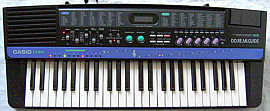 |
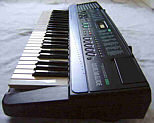 |
Unlike with modern key lighting keyboards, not the keys itself but a row of tiny LEDs above the keys flash up to teach keyboard playing, but here the LEDs are placed like musical notes on note lines to show which key belongs to which note. In opposite to earlier ROM-Pack keyboards it has not only a melody guide, but also a chord training feature, that teaches to play fingered chords.
 |
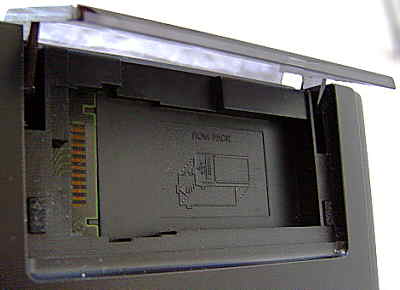 |
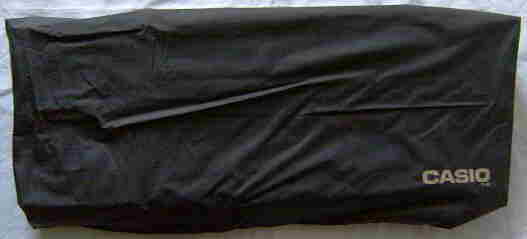 |
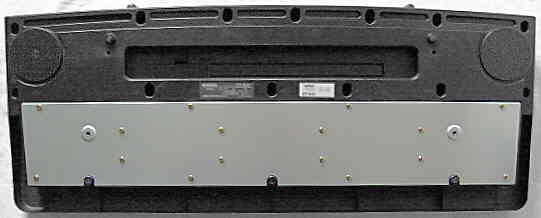 |
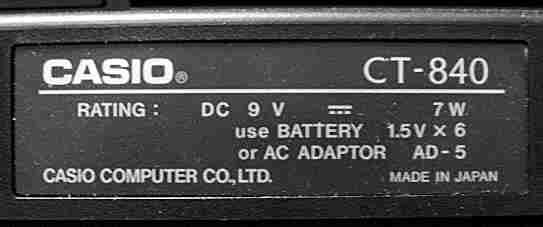 |
 |
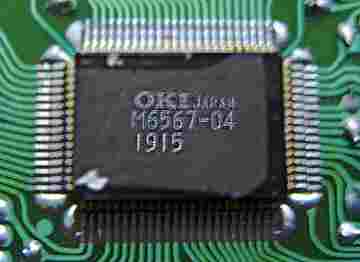 |
 |
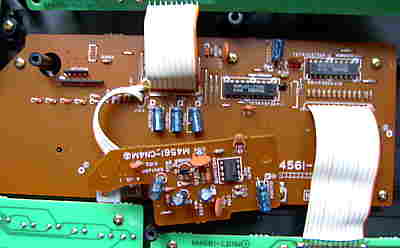 |
 |
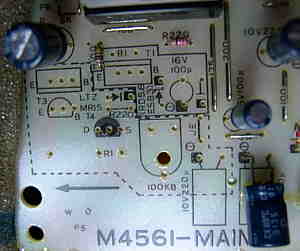 |
The sound of this instrument is almost identical with Casio MA-130 (see there) but instead of the "poly/ texture" button there is a "tone mix" button to layer any 2 preset sounds, since the tone generator apparently has doubled internal polyphony. Also the "piano" sound may have a higher resolution.
The "DO. RE. MI. Guide" button replaces the melody voice (also with demos etc.) with a monophonic Japanese child voice that sings the note names {"do"," re", "mi", "fa", "so", "la", "si", "do"}. Unlike MC-32, this one sings the correct pitch in the whole melody section of the keyboard and only repeats a higher octave in the below it. Also sharps (black keys) are sung, although as note names of the corresponding flats. The voice sings quite Engrish "le" instead of "re". The sung note is played only about 1 second long, but is truncated with even shorter note. I am not sure if this bombastically advertised hype feature really helps much with learning notes; at least the low resolution sample quality of the voice is very noisy and thus makes a nice sound effect; unfortunately it can play only monophonic.
The rhythm and accompaniment is also very similar like MA-130 (grainy lo-fi samples) with the only difference that here there is also a manual chord mode (pipe organ timbre) with rhythm off. Unfortunately it plays nothing else than standard establishment chords and stubbornly ignores any other key presses even in fingered chord mode. When new keys are pressed in the chord section, it always stops the organ chord tone for a fraction of a second, even when the new key combination continues with the same chord. (This can be also used as a sound effect.)
The 5 drumpads are very responsive and play 5 sound effects after power-on. The "phone bell" rings like a mechanical one so long the pad is held. The "laser beam" corresponds to the 3rd keyboard section of the same preset sound. The "bird tweet" is a high short synth whistle with falling pitch, the "siren 1" resembles a synth tom with falling pitch, while "siren 2" howls up with strong and fast vibrato. (Names were chosen by me since the control panel only shows icons.) The "metronome" button replaces the current rhythm with a metronome made from low and high clicking clave sounds (high for first beat of a bar, low for the others), which makes also a nice alternative rhythm, since it can be combined with the given accompaniments and switch back and forward during running accompaniment.
The chord sequencer is fairly complex but has no permanent memory and thus looses its data by power- off and even by auto power- off.
The "melody guide" key lighting feature can use as well the 5 built-in demo musics as external ROM- Pack cartridges, and you can even play their music with any of the 100 preset sounds & rhythms by switching them in between (although the programmed music may switch them back). The built-in musics are selected when no cartridge is inserted. The song "DO-RE-MI" always starts with "DO. RE. MI. Guide" enabled, thus singing its notes. Beside the melody voice, you can also train fingered chord play with this instrument, a feature that was likely first introduced with the Casio MT-820 and MT-88.
A midsize keyboard with same features like Casio CT-840 but no
key lighting and a built-in 15 song bank instead of the ROM-Pack
slot was the Casio MA-220 (seen on eBay). Smaller 100 ToneBank
instruments with ROM- Pack slot and 5 drumpads were the mini keyboard Casio
PT-88 and its midsize variant PT-380. The oldest (and most
noble sounding) ROM-Pack keyboard was the Casio
MT-800.
| removal of these screws voids warranty... | ||
 |
||
|
|